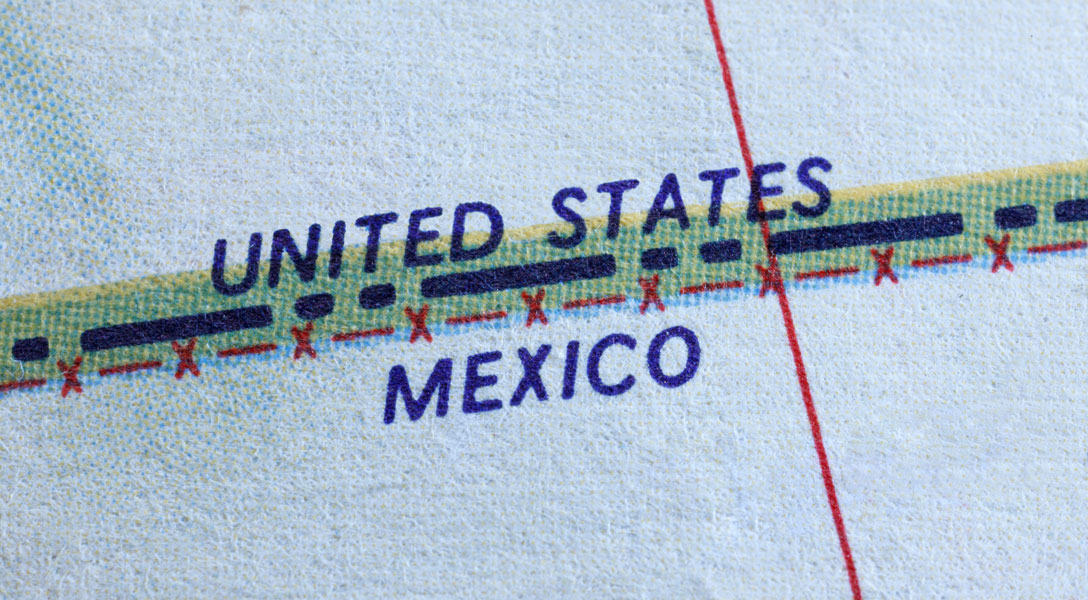
Trade binds Central America, Mexico to U.S. despite past inequities
Q. NAFTA (the North American Free Trade Agreement) ushered in an era of free trade in North America. How successful was it? How did it help Mexico?
NAFTA certainly represented the beginning of a new North American era. When President George H.W. Bush started negotiations for NAFTA, the original motivation included taking advantage of trade to promote economic growth.
Most people do not realize that it was probably even more about locking in Mexican (economic) reforms after the lost 1980s and bringing Mexico and the United States (and Canada) closer together as neighbors in both the economic and political sense. To that extent, NAFTA was tremendously successful.
Mexico did not revert to the closed economy paradigm and—except for some external shocks—has enjoyed macroeconomic stability for much of the past 30 years. NAFTA may not have lived up to the very high expectations expressed by U.S. and Mexican governments in 1992, but NAFTA helped Mexico transition from being a natural resource exporter (like Russia and other developing countries) to being a manufacturing exporter that now focuses on automobiles, electronics and aerospace.
These industries provide very good formal sector jobs that draw workers out of agriculture and motivate investment in education. Mexico’s post-NAFTA transformation remains largely unappreciated.
Q. Under NAFTA, did Mexican manufacturing workers experience improved wages and working conditions? What was the impact on U.S. workers?
President Lyndon Johnson allegedly expressed a preference for one-armed economists because he was often frustrated when economists said “… but on the other hand.” Unfortunately, there are two sides to the experiences of workers in North America because of NAFTA.
NAFTA helped hitch Mexico’s wagon to the U.S. manufacturing sectors. Integration with the U.S. manufacturing sector increased the demand for workers and was the driving engine of Mexican manufacturing employment for much of the past 30 years.
The comparison between Mexico’s north and south [regions] shows the positive benefits of NAFTA in the sense that the much-more-integrated north has much higher wages and much more manufacturing employment. Mexico’s south continues to struggle with lower wages and higher rates of agricultural employment. To that extent, one of the problems with NAFTA was that it did not go far enough to help Mexico’s south.
At the same time, U.S. manufacturing workers have had a tough 30 years since NAFTA due to technological advances and competition from China. These shocks have affected Mexico as well. Competition with China in the U.S. market hurt Mexican workers—especially women working in apparel.
In the integrated sectors, such as automobiles and other manufacturing, U.S. and Mexican manufacturing employment are highly correlated, suggesting that the U.S. and Mexico are not competing for jobs with each other as much as they are working together to produce final goods that compete in the global market.
North American integration has really helped U.S. consumers. Millions of U.S. consumers enjoy Mexican avocados and cars, for example. In the cases where U.S. workers were hurt by growing integration—and obviously, there were geographically concentrated employment losses—the U.S. government could have done much more to help workers.
Insufficient support for these workers is in many ways responsible for the backlash we see against NAFTA today. The gains from NAFTA in terms of expanding U.S. and Canadian employment due to improvements in productivity and lower prices for North American consumers receive much less media attention.
Q. Ten years after NAFTA came the Central American version, CAFTA-DR. How did it differ from NAFTA, and what was it supposed to accomplish?
CAFTA-DR includes the United States, Costa Rica, the Dominican Republic, El Salvador, Guatemala, Honduras and Nicaragua and was signed in 2004 during the George W. Bush administration. I mention the date and countries because these are very different countries from Mexico and, of course, Canada.
Generally, Central American countries have much lower incomes, more workers in agriculture and rely much less on manufacturing for exports. While Mexico primarily exports cars and car parts, the main manufacturing export from most of the Central American countries is apparel.
Apparel is often the first manufacturing sector that emerging-market countries enter along the path of economic development. While the goals of NAFTA were largely political, the goals of CAFTADR focused more on promoting trade and investment as a way to stimulate employment growth and foster stability.
Central America is an important source of U.S. immigration, and part of the logic of CAFTA-DR was to create jobs in Central America so that workers would not feel like they had to move to the U.S. to find employment.
Q. You have extensively researched apparel and textile trade under CAFTA-DR and around the world. What have you learned?
I have researched apparel trade for almost 20 years. Apparel is a really important sector because it often serves as a gateway for formal employment in developing countries. Workers come from subsistence agriculture and the informal sector to work in apparel factories. Apparel jobs are actually good jobs relative to most domestic alternatives in these countries.
It is a little bit surprising to hear apparel factory jobs described as “good” jobs, because they are often associated with the term “sweatshops” and are well known for very long hours; low wages; unfavorable working conditions, such as no temperature control and lack of safety measures; and, sometimes, outright abuse.
Compared with employment conditions in developed countries—like the U.S.—apparel jobs in developing countries are often very problematic. But the typical employment alternatives for these workers—often young, less-educated women—are even worse. Agriculture usually has much lower wages and higher accident rates and fatalities than apparel factories, for example.
Other sectors that are not “globalized,” such as agriculture and the informal sector, may not get the same attention and, as a result, have worse conditions (than apparel factories) and less hope for change. By being the entry-level job in the formal sector, apparel jobs can be a springboard for other formal employment as well and help lay the foundation for careers.
People are much less enthusiastic about trade, and the calls for “reshoring” are rising. I think that “near-shoring” that includes shifting production from China to Mexico and Central America would help promote growth in the U.S. as well as Latin America.
Because apparel is easy to start up, has a global export market and offers jobs that bring people out of agriculture and informality, developing-country governments often try to promote apparel exports. At the same time, apparel trade is highly regulated.
The apparel trade is regulated today through rules of origin clauses in trade agreements. Every trade agreement needs rules of origin because they define what “made in America”—or “made in wherever”—means.
For example, rules of origin might specify that at least 60 percent of the value of a final good must be added in Mexico for a product to be considered “made in Mexico.” If the rules of origin set the level at 50 percent, Mexico could import 40 percent worth of the final good value in parts from other countries, assemble them and then export the good as a Mexican product.
Apparel rules of origin are often much more complicated. Consider the production of a shirt. Shirts are considered “apparel” and are assembled (usually sewed) from pieces of fabric. Fabric is considered “textiles,” which is different from apparel. Fabric (textiles) is either woven or knit from yarn and threads, which are spun from, say, cotton or artificial fibers.
In some cases, rules of origin for apparel specify that not only does a shirt have to be sewn in, say, Honduras, to be counted as Honduran, but the fabric and textiles must also come from Honduras. The CAFTA-DR agreement goes even further than that. The CAFTA-DR agreement adopts a “yarn-forward” rule that says that the shirt, fabric and the yarn that goes into the fabric must come from a CAFTA-DR country.
As a result, CAFTA-DR countries that want to benefit from the provisions in the CAFTA-DR must use the relatively limited supply of fibers, threads and fabrics produced in CAFTA-DR countries. Central American countries grow very little cotton and produce even fewer artificial fibers. Even fabric production is limited in Central America.
As a result, Central America relies on U.S. thread, fibers and fabrics for its exports. Since the U.S. produces a limited range of thread, fibers and fabrics, Central American apparel exports are very limited by the agreement.
In a recent paper, I estimated the relationship between apparel trade and nearly every trade agreement in force worldwide. In some cases, such as the U.S.–Jordan agreement, there is a very large and significant trade increase. CAFTA-DR, however, is associated with approximately 70 percent less apparel trade than the “average” agreement and, shockingly, much less trade than between country pairs that have no agreement at all.
Q. Why did CAFTA-DR fail where NAFTA succeeded?
CAFTA-DR is associated with an increase in total trade that is statistically and economically significant. For apparel, however, the comparison between CAFTA-DR and NAFTA is really interesting.
In the first few years after NAFTA took effect (1994–2000), apparel trade between Mexico and the U.S. increased significantly. When China entered the World Trade Organization in 2001, however, apparel production shifted from Mexico to China.
During the 2000s, three trends have emerged. First, technology of textile production advanced, creating a wider range of fibers, yarns and textiles. Second, production, especially of textiles used in wearing apparel, shifted from the U.S. to other producers around the world. Third, being capital and technology abundant, the U.S. shifted textile production away from wearing apparel toward more advanced textile products, such as flame-resistant materials, filters and high-performance industrial fabrics.
The CAFTA-DR effectively restricted Central America’s textiles to those that remained in the U.S. As the U.S. share of the global range of textiles used in wearing apparel fell, Central America became less and less competitive because it lacked access to the global range of fabrics that consumers demanded.
Just think of how “simple” jeans have changed over the past 15 to 20 years. Jeans increasingly use “stretchy” fabrics, and there are many more available degrees of “stretchiness” in jeans. If using these newer fabrics means that you ose CAFTA-DR tariff preferences, you may want to stick with simpler products, like T-shirts.
Production shifting back to Mexico from China is generally not in apparel. Mexico is capturing much more-sophisticated goods—auto parts, electronics and aerospace.
Q. What can we do to boost economic development in Central America? Would economic development in Central America damp outmigration and take some pressure off the Southwest U.S. border?
It seems clear that the restrictive rules of origin in CAFTA-DR are holding back Central American apparel production. I estimate that if CAFTA-DR were changed so that it was associated with just the “average” increase in apparel production found in other trade agreements, about 100,000 new direct jobs would be created. This is a number that is comparable to the size of migration flows from Central America.
In other words, just updating CAFTADR would go a long way toward reducing Central American migration and promoting growth and development in the region.
Obviously, there are still some barriers to economic growth, but my estimates hold things like corruption and electricity prices constant and suggest that the trade agreement would go a long way. Furthermore, Mexico increasingly produces textiles that get exported to Central America.
To the extent that we would want to support Central America and Mexico, we should consider revising the CAFTADR to facilitate Mexico’s participation in textile production for Central America. Expanding the agreement to allow textile (and other) production from other countries, such as Colombia, would also promote development and stability in the region.
Q. Geopolitical tension is rising around the world, and global supply chains are under pressure. Are we seeing the end of the post-World War II free trade era?
I think a lot of people see the COVID-19 crisis as a turning point in global trade, but the data suggest that the last financial crisis (2007–09) was a turning point for globalization. The share of trade in global GDP has either remained constant or has been falling since then.
People are much less enthusiastic about trade, and the calls for “reshoring” are rising. I think that “near-shoring” that includes shifting production from China to Mexico and Central America would help promote growth in the U.S. as well as Latin America.
We should be thinking of this kind of integration more than complete reshoring because it’s pretty clear from the last 20 years that manufacturers would respond to government pressure to reshore by increasing automation rather than bringing a lot of jobs back to the U.S.
If we want to create jobs here, we need to increase exports. Mexico and Central America buy much more, per dollar of income, than China or other East Asian countries. Expanding employment in Mexico and Central America is a way to boost U.S. exports and, therefore, U.S. jobs.
And if the production shifts from China, it’s going to be difficult to argue that Mexican or Central American development comes at the expense of U.S. jobs. Economic integration in the Americas is a win-win solution.
Southwest Economy is published quarterly by the Federal Reserve Bank of Dallas. The views expressed are those of the authors and should not be attributed to the Federal Reserve Bank of Dallas or the Federal Reserve System.
Articles may be reprinted on the condition that the source is credited to the Federal Reserve Bank of Dallas.
Full publication is available online: www.dallasfed.org/research/swe/2022/swe2202.




